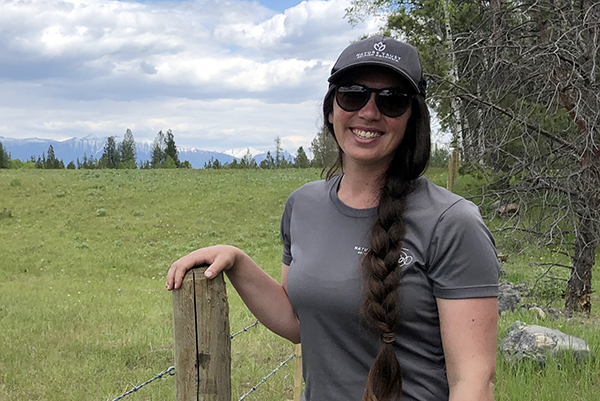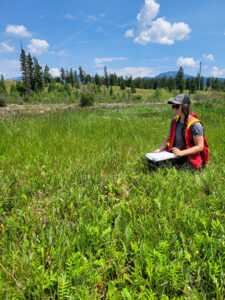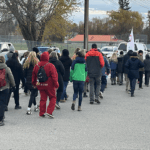Home »

Restoring natural landscapes with NTBC
By Megan Jamison
Kootenay Conservation Program
Michelle Daniel, Kootenay Conservation Land Coordinator with The Nature Trust of BC (NTBC), is passionate about ecosystem enhancement and restoration—especially when collaborating with NTBC’s partner organizations.
“My favourite thing to do is to get out on the land with experts who are passionate about their work. When they share their knowledge, enthusiasm and recommendations, we’re often able to make a meaningful improvement based on their suggestions, and sometimes a large-scale project even grows out of the discussion. Many of these partnerships have been forged through gatherings and meetings coordinated by Kootenay Conservation Program (KCP). It is always exciting to meet new people…It’s been immensely valuable in our work to build these connections.”

Joining NTBC in 2021 as a Field Operations Technician, Michelle now leads field crews, manages projects, and continues to do hands-on work.
She explains that NTBC “is a land trust working to conserve B.C.’s biodiversity by identifying and securing lands of high ecological value and managing them. This includes conservation-focused actions to keep what is already there in good shape, and often restoration and enhancement opportunities.”
One major initiative is the Bull River Grassland Corridor Habitat Enhancement project, taking place in a fire-maintained landscape that is now overgrown. The project targets habitat for bighorn sheep, elk, white-tailed and mule deer, American badgers, birds, and bats by restoring connectivity between the Bull River Valley and higher elevations.
“Our vision is to revitalize a mosaic that would have existed here in a historically fire‑maintained ecosystem. We began with some hand thinning, and have completed about seven hectares already. The plan this coming winter is to do an intensive mechanized harvest, targeting about 20 hectares, which will be an exciting core achievement for the project.”
The work also involves removing derelict fencing, buildings, cement pads, and engaging volunteers to dismantle hazards. “We also plan to follow up with wildlife tree recruitment focused on birds and bats, as we really want to encourage biodiversity in the tree canopy as well as in the understory.”
Another key project is at Hoodoos Westside Conservation Area near Fairmont Hot Springs, NTBC’s largest site which they have stewarded since 2003. Michelle is planning additional forest thinning treatments to maintain the work done several years ago.
“With such a big area, there are more units to treat and do enhancement work in, with a large emphasis on habitat for ungulate species. The Hoodoos Conservation Complex forms a valuable corridor between the Columbia River Wetlands into the upland area.”
Michelle underscores the importance of partnerships and landscape-wide coordination. She works with the East Kootenay Invasive Species Council (EKISC) for plant inventories, and invasive species management such as pre-treatments before machinery goes in.
“During enhancement projects, pre-treatment ensures the thinning work won’t be spreading invasive species. The follow-up treatments ensure we’re encouraging growth of the native plant communities, to enhance the value of the habitat for wildlife populations.”
Her holistic approach looks at the ecological values of the habitat, including the plant communities and how the NTBC-managed areas tie into conservation at the landscape level.
“We view our forest thinning work through the lens of ecosystem restoration, with some impetus also coming from wildfire risk reduction. There are fantastic synergies when opening areas back up – this also decreases the available fuel for wildfires. We look for opportunities for efficiencies; for example, when another partner group or the province might be undertaking similar work. There’s also the great reward of the landscape level benefits, such as the multi-partner project at the Wycliffe Conservation Complex.”
Michelle grew up near Toronto, earning a BSc in Forest Conservation Science from the University of Toronto and a certificate in Ecological Restoration from the University of Victoria. Her career has included roles in silviculture and the wildfire service before joining NTBC. She moved to the Kootenays for downhill skiing opportunities and now enjoys cross‑country skiing in Kimberley, and summer moments by local lakes.
Michelle Daniel’s leadership combines field expertise, local partnerships, and a commitment to restoring and conserving biodiversity across the Kootenays—protecting both species and landscapes for generations.
Kootenay Conservation Program (KCP) is a partnership of over 85 organizations that work together for connected habitats and landscapes in the Kootenays that sustain biodiversity and naturally functioning resilient ecosystems that, in turn, support community well-being. Learn more at www.kootenayconservation.ca.
Lead image: Michelle Daniel is Kootenay Conservation Land Coordinator with The Nature Trust of BC (NTBC). Photos submitted







